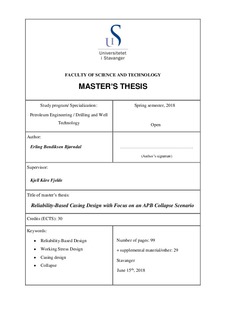| dc.contributor.advisor | Fjelde, Kjell Kåre | |
| dc.contributor.author | Bjørndal, Erling | |
| dc.date.accessioned | 2018-10-30T15:09:40Z | |
| dc.date.available | 2018-10-30T15:09:40Z | |
| dc.date.issued | 2018-06-15 | |
| dc.identifier.uri | http://hdl.handle.net/11250/2570245 | |
| dc.description | Master's thesis in Petroleum Engineering | nb_NO |
| dc.description.abstract | In times of unstable oil price, optimization related to casing and tubing design becomes more important than ever. Reducing cost and at the same time ensuring reliable and safe drilling and completion installations becomes a challenge to the petroleum industry. Reliability-based casing and tubing design allows for optimization of design by quantifying a probability of failure.
The conventional method for casing and tubing design, working stress design, relies on the application of design factors that to a large degree is based on company specific guidelines. This method is deterministic and overly conservative. It also lacks the ability to quantify the reliability of the design. It does not take into account varying uncertainties in load and strength, or the variation in consequence of failure for different well or completion designs.
Quantitative Risk Analysis is a method used to quantify risk by predicting the failure probability, in combination with Monte Carlo Simulation, the method will account for uncertainty in multiple variables involved in load and strength estimation. Load and strength will be represented by probability distributions which will define the failure probability, one may allow for an acceptable failure probability in the design.
This study provides an overview of theory and methods that can be used for reliability-based casing and tubing design. In addition, an attempt is made to illustrate the implementation of Quantitative Risk Analysis by the use of Monte Carlo Simulation on a collapse mode tubing design. A case study is prepared, considering a collapse load on a production tubing caused by Annular Pressure Buildup in the A annulus.
The Reliability-based design approach is compared to that of the deterministic working stress design for the case study tubing string. The case study show that significantly lower required yield strength of the tubing string can be obtained when replacing working stress design by a reliability-based approach. Acceptable probabilities of failure can be selected based on the cost and consequence of an anticipated failure, thus a reliability-based design is more flexible as it can be tailored to specific well and field conditions. Two different probabilities were considered for the design. As the reliability-based approach predicts the failure probability, it gives a better view of the real risk involved in the design. The study shows that savings in yield strength or tubing grade depend on both the selected acceptable failure probability and on the type of reliability-based design being used. | nb_NO |
| dc.language.iso | eng | nb_NO |
| dc.publisher | University of Stavanger, Norway | nb_NO |
| dc.relation.ispartofseries | Masteroppgave/UIS-TN-IEP/2018; | |
| dc.subject | petroleumsteknologi | nb_NO |
| dc.subject | petroleum technology | nb_NO |
| dc.subject | boreteknologi | nb_NO |
| dc.subject | brønnteknologi | nb_NO |
| dc.title | Reliability-Based Casing Design with Focus on an APB Collapse Scenario | nb_NO |
| dc.type | Master thesis | nb_NO |
| dc.subject.nsi | VDP::Teknologi: 500::Berg‑ og petroleumsfag: 510::Petroleumsteknologi: 512 | nb_NO |
